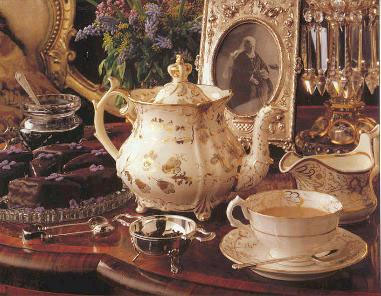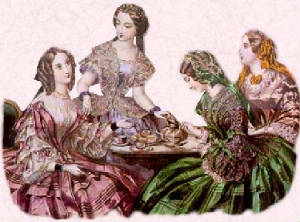 Because
tea was such a dear comodity, early tea pots were extremely small. As it became cheaper, pots became larger. Elaborate
tea caddies were made and were kept under lock and key. They had two compartments, one for green tea, and one for black.
Sugar, another expensive item, was often kept there also where it could be safely locked up. Ladies of the house usually
kept the key to the tea caddy on their belt, on a chatelaine. It was an expensive treat only offered to the most important
visitors.
The
first tea is credited to Anna, the 7th Dutchess of Bedford, who instituded the afternoon tea early in the 19th century when
she decided to take tea to asuage the hunger of afternoon between dinner amd supper. Soon she was inviting friends to
join her for her tea, around 3:00pm or 4:00pm, and served a light luncheon of tea, sandwiches, small cakes and sweets.
In time, the afternoon
teas became more elaboate, as did the tea service. Ladies doned their finest gowns for daytime wear, traveled by carriage
to friends homes, to dine on an aray of light refreshments and discuss the topics of the day.
Tea
services grew to encompass cake stands, side plates, butter plates, spoon rests,
serving plates, and container imaginable. Of course, one had to have the right container for each different food!
Local custom decreed when the tea actually started, anywhere from 2 till 5. So important was the social implications
of tea, etiquette books were full of advice on everything from how to remove the spoon to proper conversation topics.
Only
simple refreshments should be served at an afternoon tea. Thin slices of bread and butter, sandwiches, fancy biscuits
or cake, tea, coffee, or chocolate, ice-cream, and bullion are offered. Punch and lemonade- but no wine of any kind-
may be added if desired; and also salted almonds, cakes, candies, and other dainty truffles.
The
hostess should shake hands with her guests and receive them cordially; any formality is out of place on an informal occasion.
If the number of guests is small, the hostess should walk about the room, talking with her visitors;
if large, she should remain near the door, and have the aid of other ladies, who should entertain the guests, ask them to
take refreshments, and make introductions, when necessary.
At a large and elegant
afternoon reception, the windows may be darkened, the oil lamp lit, and musicians employed, if the hostess desires.
 The 19th century was the era when "Taking Tea" evolved from simple afternoon refreshment into a social ritual,
complete with its own rules of etiquette and a full line of accoutrements.
The "taking of tea" came in several varieties, and each type of "Tea" included different menus. Here
is a brief explanation of various "Teas" and their menu:
Afternoon Tea: Includes finger sandwiches (small crustless sandwiches
with various different fillings), bread and butter, scones, sweets (jams, jellies, and honey), desserts, and tea.
Royal Tea: Afternoon Tea, with the additon of champagne or sherry.
Light Tea: A lighter version of Afternoon Tea, at which only scones,
sweets, and tea are served.
Cream Tea: An English favorite which includes scones, jams, "clotted
cream" (buttery cream that is thick enough to spread), and of course...tea.
High Tea: Often confused with "Afternoon Tea", but "High Tea" is a hearty,
sit-down meal, consisting of an extensive menu of meat pies, sausage, cold cuts, breads, jam, butter, cheese, desserts, seasonal
fruit, and naturally...tea! ---In addition to all this, it might even include potted fish, salads, biscuits, or crumpets,
as well!
|

